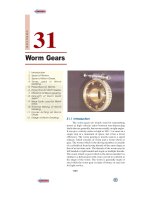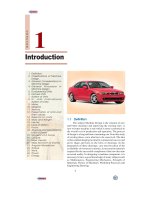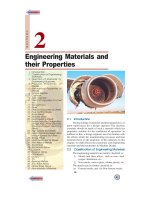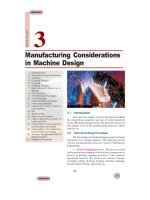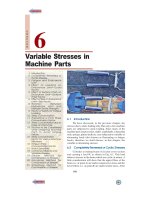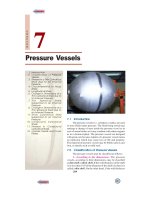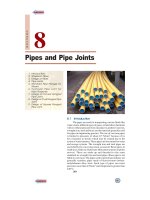Tài liệu Text Book of Machine Design P1 docx
Bạn đang xem bản rút gọn của tài liệu. Xem và tải ngay bản đầy đủ của tài liệu tại đây (262.35 KB, 15 trang )
Introduction
1
1. Definition.
2. Classifications of Machine
Design.
3. General Considerations in
Machine Design.
4. General Procedure in
Machine Design.
5. Fundamental Units.
6. Derived Units.
7. System of Units.
8. S.I. Units (International
System of Units).
9. Metre.
10. Kilogram.
11. Second.
12. Presentation of Units and
their values.
13. Rules for S.I. Units.
14. Mass and Weight.
15. Inertia.
16. Laws of Motion.
17. Force.
18. Absolute and Gravitational
Units of Force.
19. Moment of a Force.
20. Couple.
21. Mass Density.
22. Mass Moment of Inertia.
23. Angular Momentum.
24. Torque.
25. Work.
26. Power.
27. Energy.
1
C
H
A
P
T
E
R
1.11.1
1.11.1
1.1
DefinitionDefinition
DefinitionDefinition
Definition
The subject Machine Design is the creation of new
and better machines and improving the existing ones. A
new or better machine is one which is more economical in
the overall cost of production and operation. The process
of design is a long and time consuming one. From the study
of existing ideas, a new idea has to be conceived. The idea
is then studied keeping in mind its commercial success and
given shape and form in the form of drawings. In the
preparation of these drawings, care must be taken of the
availability of resources in money, in men and in materials
required for the successful completion of the new idea into
an actual reality. In designing a machine component, it is
necessary to have a good knowledge of many subjects such
as Mathematics, Engineering Mechanics, Strength of
Materials, Theory of Machines, Workshop Processes and
Engineering Drawing.
CONTENTS
CONTENTS
CONTENTS
CONTENTS
2
n
A Textbook of Machine Design
1.21.2
1.21.2
1.2
Classifications of Machine DesignClassifications of Machine Design
Classifications of Machine DesignClassifications of Machine Design
Classifications of Machine Design
The machine design may be classified as follows :
1. Adaptive design. In most cases, the designer’s work is concerned with adaptation of existing
designs. This type of design needs no special knowledge or skill and can be attempted by designers of
ordinary technical training. The designer only makes minor alternation or modification in the existing
designs of the product.
2. Development design. This type of design needs considerable scientific training and design
ability in order to modify the existing designs into a new idea by adopting a new material or different
method of manufacture. In this case, though the designer starts from the existing design, but the final
product may differ quite markedly from the original product.
3. New design. This type of design needs lot of research, technical ability and creative think-
ing. Only those designers who have personal qualities of a sufficiently high order can take up the
work of a new design.
The designs, depending upon the methods used, may be classified as follows :
(a) Rational design. This type of design depends upon mathematical formulae of principle of
mechanics.
(b) Empirical design. This type of design depends upon empirical formulae based on the practice
and past experience.
(c) Industrial design. This type of design depends upon the production aspects to manufacture
any machine component in the industry.
(d) Optimum design. It is the best design for the given objective function under the specified
constraints. It may be achieved by minimising the undesirable effects.
(e) System design. It is the design of any complex mechanical system like a motor car.
(f) Element design. It is the design of any element of the mechanical system like piston,
crankshaft, connecting rod, etc.
(g) Computer aided design. This type of design depends upon the use of computer systems to
assist in the creation, modification, analysis and optimisation of a design.
1.31.3
1.31.3
1.3
General Considerations in Machine DesignGeneral Considerations in Machine Design
General Considerations in Machine DesignGeneral Considerations in Machine Design
General Considerations in Machine Design
Following are the general considerations in designing a machine component :
1. Type of load and stresses caused by the load. The load, on a machine component, may act
in several ways due to which the internal stresses are set up. The various types of load and stresses are
discussed in chapters 4 and 5.
2. Motion of the parts or kinematics of the machine. The successful operation of any ma-
chine depends largely upon the simplest arrangement of the parts which will give the motion required.
The motion of the parts may be :
(a) Rectilinear motion which includes unidirectional and reciprocating motions.
(b) Curvilinear motion which includes rotary, oscillatory and simple harmonic.
(c) Constant velocity.
(d) Constant or variable acceleration.
3. Selection of materials. It is essential that a designer should have a thorough knowledge of
the properties of the materials and their behaviour under working conditions. Some of the important
characteristics of materials are : strength, durability, flexibility, weight, resistance to heat and corro-
sion, ability to cast, welded or hardened, machinability, electrical conductivity, etc. The various types
of engineering materials and their properties are discussed in chapter 2.
Introduction
n
3
4. Form and size of the parts. The form and size are based on judgement. The smallest prac-
ticable cross-section may be used, but it may be checked that the stresses induced in the designed
cross-section are reasonably safe. In order to design any machine part for form and size, it is neces-
sary to know the forces which the part must sustain. It is also important to anticipate any suddenly
applied or impact load which may cause failure.
5. Frictional resistance and lubrication. There is always a loss of power due to frictional
resistance and it should be noted that the friction of starting is higher than that of running friction. It
is, therefore, essential that a careful attention must be given to the matter of lubrication of all surfaces
which move in contact with others, whether in rotating, sliding, or rolling bearings.
6. Convenient and economical features. In designing, the operating features of the machine
should be carefully studied. The starting, controlling and stopping levers should be located on the
basis of convenient handling. The adjustment for wear must be provided employing the various take-
up devices and arranging them so that the alignment of parts is preserved. If parts are to be changed
for different products or replaced on account of wear or breakage, easy access should be provided
and the necessity of removing other parts to accomplish this should be avoided if possible.
The economical operation of a machine which is to be used for production, or for the processing
of material should be studied, in order to learn whether it has the maximum capacity consistent with
the production of good work.
7. Use of standard parts. The
use of standard parts is closely related
to cost, because the cost of standard
or stock parts is only a fraction of the
cost of similar parts made to order.
The standard or stock parts
should be used whenever possible ;
parts for which patterns are already
in existence such as gears, pulleys and
bearings and parts which may be
selected from regular shop stock such
as screws, nuts and pins. Bolts and
studs should be as few as possible to
avoid the delay caused by changing
drills, reamers and taps and also to
decrease the number of wrenches required.
8. Safety of operation. Some machines are dangerous to operate, especially those which are
speeded up to insure production at a maximum rate. Therefore, any moving part of a machine which
is within the zone of a worker is considered an accident hazard and may be the cause of an injury. It
is, therefore, necessary that a designer should always provide safety devices for the safety of the
operator. The safety appliances should in no way interfere with operation of the machine.
9. Workshop facilities. A design engineer should be familiar with the limitations of his
employer’s workshop, in order to avoid the necessity of having work done in some other workshop.
It is sometimes necessary to plan and supervise the workshop operations and to draft methods for
casting, handling and machining special parts.
10. Number of machines to be manufactured. The number of articles or machines to be manu-
factured affects the design in a number of ways. The engineering and shop costs which are called
fixed charges or overhead expenses are distributed over the number of articles to be manufactured. If
only a few articles are to be made, extra expenses are not justified unless the machine is large or of
some special design. An order calling for small number of the product will not permit any undue
Design considerations play important role in the successful
production of machines.
4
n
A Textbook of Machine Design
expense in the workshop processes, so that the designer should restrict his specification to standard
parts as much as possible.
11. Cost of construction. The cost of construction of an article is the most important consideration
involved in design. In some cases, it is quite possible that the high cost of an article may immediately
bar it from further considerations. If an article has been invented and tests of hand made samples have
shown that it has commercial value, it is then possible to justify the expenditure of a considerable sum
of money in the design and development of automatic machines to produce the article, especially if it
can be sold in large numbers. The aim
of design engineer under all
conditions, should be to reduce the
manufacturing cost to the minimum.
12. Assembling. Every
machine or structure must be
assembled as a unit before it can
function. Large units must often be
assembled in the shop, tested and
then taken to be transported to their
place of service. The final location
of any machine is important and the
design engineer must anticipate the
exact location and the local facilities
for erection.
1.41.4
1.41.4
1.4
General PrGeneral Pr
General PrGeneral Pr
General Pr
ocedurocedur
ocedurocedur
ocedur
e in Machine Designe in Machine Design
e in Machine Designe in Machine Design
e in Machine Design
In designing a machine component, there is no rigid rule. The
problem may be attempted in several ways. However, the general
procedure to solve a design problem is as follows :
1. Recognition of need. First of all, make a complete statement
of the problem, indicating the need, aim or purpose for which the
machine is to be designed.
2. Synthesis (Mechanisms). Select the possible mechanism or
group of mechanisms which will give the desired motion.
3. Analysis of forces. Find the forces acting on each member
of the machine and the energy transmitted by each member.
4. Material selection. Select the material best suited for each
member of the machine.
5. Design of elements (Size and Stresses). Find the size of
each member of the machine by considering the force acting on the
member and the permissible stresses for the material used. It should
be kept in mind that each member should not deflect or deform than
the permissible limit.
6. Modification. Modify the size of the member to agree with
the past experience and judgment to facilitate manufacture. The
modification may also be necessary by consideration of manufacturing
to reduce overall cost.
7. Detailed drawing. Draw the detailed drawing of each component and the assembly of the
machine with complete specification for the manufacturing processes suggested.
8. Production. The component, as per the drawing, is manufactured in the workshop.
The flow chart for the general procedure in machine design is shown in Fig. 1.1.
Fig. 1.1. General procedure in
Machine Design.
Car assembly line.
Introduction
n
5
Note : When there are number of components in the market having the same qualities of efficiency, durability
and cost, then the customer will naturally attract towards the most appealing product. The aesthetic and
ergonomics are very important features which gives grace and lustre to product and dominates the market.
1.51.5
1.51.5
1.5
Fundamental UnitsFundamental Units
Fundamental UnitsFundamental Units
Fundamental Units
The measurement of physical quantities is one of the most important operations in engineering.
Every quantity is measured in terms of some arbitrary, but internationally accepted units, called
fundamental units.
1.61.6
1.61.6
1.6
Derived UnitsDerived Units
Derived UnitsDerived Units
Derived Units
Some units are expressed in terms of other units, which are derived from fundamental units, are
known as derived units e.g. the unit of area, velocity, acceleration, pressure, etc.
1.71.7
1.71.7
1.7
System of UnitsSystem of Units
System of UnitsSystem of Units
System of Units
There are only four systems of units, which are commonly used and universally recognised.
These are known as :
1. C.G.S. units, 2. F.P.S. units, 3. M.K.S. units, and 4. S.I. units.
Since the present course of studies are conducted in S.I. system of units, therefore, we shall
discuss this system of unit only.
1.81.8
1.81.8
1.8
S.I.S.I.
S.I.S.I.
S.I.
Units (Inter Units (Inter
Units (Inter Units (Inter
Units (Inter
nana
nana
na
tional System of Units)tional System of Units)
tional System of Units)tional System of Units)
tional System of Units)
The 11th General Conference* of Weights and Measures have recommended a unified and
systematically constituted system of fundamental and derived units for international use. This system
is now being used in many countries. In India, the standards of Weights and Measures Act 1956 (vide
which we switched over to M.K.S. units) has been revised to recognise all the S.I. units in industry
and commerce.
In this system of units, there are seven fundamental units and two supplementary units, which
cover the entire field of science and engineering. These units are shown in Table 1.1
TT
TT
T
aa
aa
a
ble 1.1.ble 1.1.
ble 1.1.ble 1.1.
ble 1.1.
Fundamental and supplementar Fundamental and supplementar
Fundamental and supplementar Fundamental and supplementar
Fundamental and supplementar
y unitsy units
y unitsy units
y units
..
..
.
S.No. Physical quantity Unit
Fundamental units
1. Length (l) Metre (m)
2. Mass (m) Kilogram (kg)
3. Time (t) Second (s)
4. Temperature (T) Kelvin (K)
5. Electric current (I) Ampere (A)
6. Luminous intensity(Iv) Candela (cd)
7. Amount of substance (n) Mole (mol)
Supplementary units
1. Plane angle (α, β, θ, φ ) Radian (rad)
2. Solid angle (Ω) Steradian (sr)
* It is known as General Conference of Weights and Measures (G.C.W.M). It is an international
organisation of which most of the advanced and developing countries (including India) are members.
The conference has been entrusted with the task of prescribing definitions for various units of weights
and measures, which are the very basics of science and technology today.
6
n
A Textbook of Machine Design
The derived units, which will be commonly used in this book, are given in Table 1.2.
TT
TT
T
aa
aa
a
ble 1.2.ble 1.2.
ble 1.2.ble 1.2.
ble 1.2.
Der Der
Der Der
Der
iviv
iviv
iv
ed unitsed units
ed unitsed units
ed units
..
..
.
S.No. Quantity Symbol Units
1. Linear velocity V m/s
2. Linear acceleration a m/s
2
3. Angular velocity ω rad/s
4. Angular acceleration α rad/s
2
5. Mass density ρ kg/m
3
6. Force, Weight F, W N ; 1N = 1kg-m/s
2
7. Pressure P N/m
2
8. Work, Energy, Enthalpy W, E, H J ; 1J = 1N-m
9. Power P W ; 1W = 1J/s
10. Absolute or dynamic viscosity µ N-s/m
2
11. Kinematic viscosity v m
2
/s
12. Frequency f Hz ; 1Hz = 1cycle/s
13. Gas constant R J/kg K
14. Thermal conductance h W/m
2
K
15. Thermal conductivity k W/m K
16. Specific heat c J/kg K
17. Molar mass or Molecular mass M kg/mol
1.91.9
1.91.9
1.9
MetrMetr
MetrMetr
Metr
ee
ee
e
The metre is defined as the length equal to 1 650 763.73 wavelengths in vacuum of the radiation
corresponding to the transition between the levels 2 p
10
and 5 d
5
of the Krypton– 86 atom.
1.101.10
1.101.10
1.10
KilogramKilogram
KilogramKilogram
Kilogram
The kilogram is defined as the mass of international prototype (standard block of platinum-
iridium alloy) of the kilogram, kept at the International Bureau of Weights and Measures at Sevres
near Paris.
1.111.11
1.111.11
1.11
SecondSecond
SecondSecond
Second
The second is defined as the duration of 9 192 631 770 periods of the radiation corresponding
to the transition between the two hyperfine levels of the ground state of the caesium – 133 atom.
1.121.12
1.121.12
1.12
PrPr
PrPr
Pr
esentaesenta
esentaesenta
esenta
tion of Units and their tion of Units and their
tion of Units and their tion of Units and their
tion of Units and their
VV
VV
V
aluesalues
aluesalues
alues
The frequent changes in the present day life are facilitated by an international body known as
International Standard Organisation (ISO) which makes recommendations regarding international
standard procedures. The implementation of lSO recommendations, in a country, is assisted by its
organisation appointed for the purpose. In India, Bureau of Indian Standards (BIS), has been created
for this purpose. We have already discussed that the fundamental units in S.I. units for length, mass
and time is metre, kilogram and second respectively. But in actual practice, it is not necessary to
express all lengths in metres, all masses in kilograms and all times in seconds. We shall, sometimes,
use the convenient units, which are multiples or divisions of our basic units in tens. As a typical
example, although the metre is the unit of length, yet a smaller length of one-thousandth of a metre
proves to be more convenient unit, especially in the dimensioning of drawings. Such convenient units

